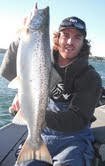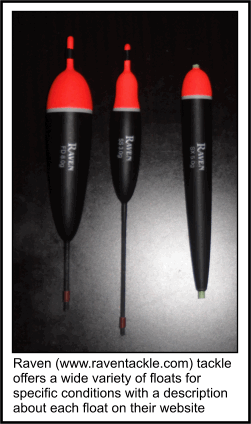|

Ontario Campgrounds
|
 Spring
Steelhead – A Newbie’s Gear Guide Spring
Steelhead – A Newbie’s Gear Guide
By: Tyler Dunn
Tyler Dunn Guiding
 With
the spring thaw only a few weeks away. Ontario
steelhead bums like myself, are anxiously
waiting for the rivers to open up enough to get
a drift in. No doubt, the next few months is my
favourite time of year. Migratory trout have
already begun to stage and even move into rivers
throughout all of the Great Lakes. The next few
weeks bring on a massive run of these chrome
beauties. An easy and the very exciting method
to catch a steelhead is under a float. The
following is a simple guideline for any new
comers looking to pursue float fishing for
steelhead on the Great Lakes tributaries. With
the spring thaw only a few weeks away. Ontario
steelhead bums like myself, are anxiously
waiting for the rivers to open up enough to get
a drift in. No doubt, the next few months is my
favourite time of year. Migratory trout have
already begun to stage and even move into rivers
throughout all of the Great Lakes. The next few
weeks bring on a massive run of these chrome
beauties. An easy and the very exciting method
to catch a steelhead is under a float. The
following is a simple guideline for any new
comers looking to pursue float fishing for
steelhead on the Great Lakes tributaries.
 Rods Rods
Long rods in the 10-15 foot length specifically
made for float fishing are standard on the river
banks throughout Ontario. In extremely tight
conditions with areas that are thick with brush.
A rod over 10 feet is a disability rather than
an asset. A few trickles, I fish north of Sault
Ste. Marie during high water conditions call for
rods in the 8 and 9 foot lengths. That being
said, a rod in the 13 foot range is an ideal
length for almost any river in Ontario. A 13
foot rod gives you the ability to achieve super
long drifts but is still short enough to
manoeuvre in most situations, fairly easy.
Reels
Float fishing reels can either be spinning, bait
casting or centerpins. I began my steelhead
adventures with a spinning reel. Slowly, I
mastered the spinning reel which I caught more
than my fair share of fish with. Since then I
have moved onto a centerpin reel. These reels
offer the angler direct contact to the float and
gives them an amazing ability to cover huge
sections of water. Centerpins prevent your line
from touching the water giving you the ability
to precisely control your float. Not only do
these reels give you more control but they
increase the length of a drift. I was in utter
amazement when I first began to ``pin`` and
realized I was cutting myself with a spinning
reel. I still bring a spinning reel but it is
only used for chucking hardware and bouncing
bottom during the right conditions.
 Floats Floats
Another key ingredient to a successful day on
the riverbanks is your float. Choosing the
correct float for the conditions you are faced
with can sometimes become confusing. With so
many colours and styles available it is tough to
make the correct choices as a newbie. When I
started out on the rivers, I made up something
that would help me remember which float to use.
I had 2 categories- fat and skinny. It was fat
for fast flows and skinny for slow flows. It was
kind of like a lefty, loosely, righty, tighty
thing to me.
Line
Monofilament is the most commonly used line by
anglers when chasing river-run steelies. 8-10
pound is the norm with heavier pound test used
on huge flows light the Niagara or in Western
Canada. Steelhead are known to be spooky at
times so a thin diameter leader line in the 4-8
pound range is most commonly used a s a leader.
Fluorocarbon which is supposed to be transparent
under water is recommended in super, gin clear
conditions but I have caught plenty of fish on
plain old monofilament in clear and stained
water. Fluorocarbon as a mainline on the other
hand is not a good choice. The properties in
fluorocarbon make the line sink rather than
float like a monofilament or braid. Always be
sure to have your leader at least 2# lighter
than you’re mainline. This will prevent you from
losing your whole set-up on snags.
Even with no experience any angler with time and
patience can evolve into a steelhead catching
machine. Give float fishing a try this spring!
You will not be disappointed!
|